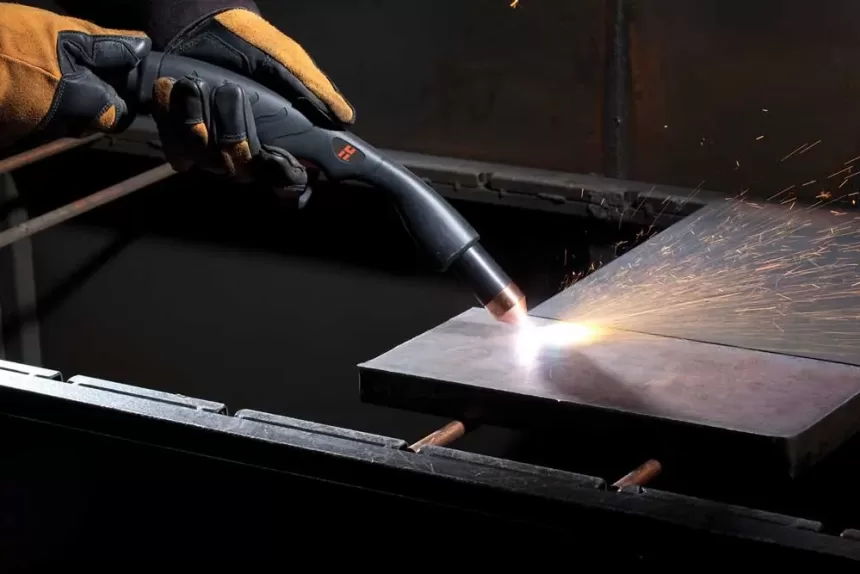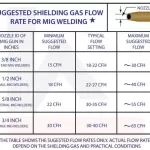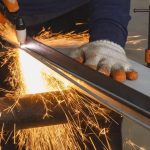Modern industry depends on the manipulation of heavy metal and alloys, as we need metals to build the tools and transportation necessary for day-to-day business. For example, we build cranes, cars, skyscrapers, robots, and suspension bridges out of precisely formed metal components. However, humankind would have an incredibly tough time building any of these things without the advancements of plasma cutting.
How Does A Plasma Cutter Work
Welding Town
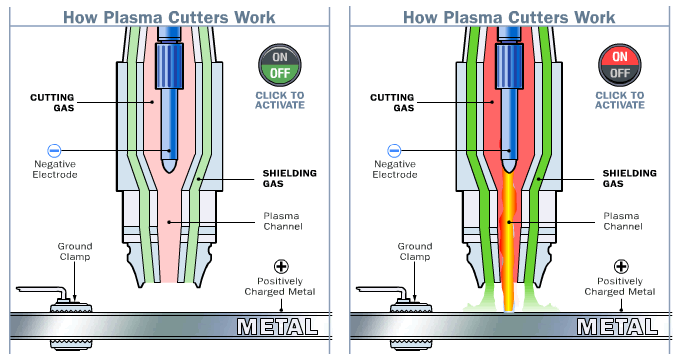
Metals are extremely strong and durable, so they’re the logical choice for most things that need to be especially big, especially sturdy, or both. Yet, the funny thing is that metal’s strength is also a weakness. Because metal is so good at resisting damage, it’s very difficult to manipulate and form into specialized pieces. So how do people precisely cut and manipulate the metals needed to build something as large and as strong as an airplane wing?
In most cases, the answer is the plasma cutter. It may sound like something out of a sci-fi novel, but the plasma cutter is actually a common tool that has been around since World War II. Conceptually, a plasma cutter is extremely simple. It gets the job done by harnessing one of the most prevalent states of matter in the visible universe. In this article, we’ll cut through the mystery surrounding plasma cutting and see how one of the most fascinating tools has shaped the world around us.
What is Plasma?
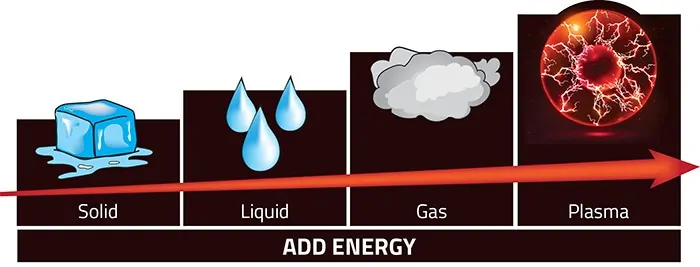
Plasma is one of the four fundamental state of matter after solid, liquid and gas.
It consists of gas of ions and free electron.
Like gas, plasma does not have definite shape or volume.
Unlike gas, plasma is electrically conductive.
It produces magnetic fields and electric current and respond strongly to electromagnetic forces.
Plasma can be artificially generated by two ways: by heating a neutral gas or subjecting it to a strong electromagnetic field.
The plasma used in plasma cutting machine is generated by heating a passing gas such as nitrogen, argon, oxygen etc.
The passing gas is heated by sending electric arc through it.
Origins of the Plasma Arc Cutting Process
In World War II, U.S. factories were cranking out armor, ordnance, and aircraft almost five times faster than the Axis powers. This was largely thanks to private industry’s tremendous innovations in the field of mass production.
One area of innovation rose out of the need to cut and join aircraft parts more efficiently. Many factories working on military aircraft adopted a new method of welding that involved the use of an inert gas fed through an electric arc. The breakthrough discovery was that charging the gas with an electric current formed a barrier around the weld, which protected it from oxidation. This new method — called plasma arc cutting — made for much cleaner lines at the joints and much sturdier construction.
In the early 1960s, engineers made a new discovery. They figured out that they could boost temperatures by speeding up the flow of gas and shrinking the release hole. The new system could reach higher temperatures than any other commercial welder. In fact, at these high temperatures, the tool no longer acted as a welder. Instead, it worked like a saw, cutting through tough metals like a hot knife through butter.
Like a futuristic laser cutting machine, plasma arc cutting revolutionized the speed, accuracy, and types of cuts manufacturers could make in all types of metals. In the next section, we’ll examine the science behind this system.
States of Matter
A plasma cutter can pass through metals with little or no resistance thanks to the unique properties of plasma. So what is plasma?
There are four states of matter in the world. Most things we deal with in our daily lives are in the form of solids, liquids, or gases. These states are divided based on the way that molecules behave within each one. Take water as an example:
- As a solid, water takes the form of ice. Ice is made up of neutrally charged atoms arranged in a hexagonal pattern that forms a solid. Because the molecules stay fairly still relative to each other, they form a solid — something that holds its shape.
- As a liquid, water takes its drinkable form. The molecules are still bound to each other, but they move relative to each other at slow speeds. The liquid has a fixed volume, but no constant shape. It changes shape to fit whatever container you put it in.
- As a gas, water takes the form of steam. In steam, molecules move around at high speeds, independently of each other. Because the molecules are not bound to each other, a gas has no fixed shape or fixed volume.
So what’s the fourth state of matter?
How to Create Plasma Gas
The amount of heat (which translates to the amount of energy) applied to water molecules determines their behavior and therefore their state. Simply put, more heat (more energy) excites molecules to the point that they break free of bonds that bind them together.
With minimal heat, the molecules are tightly bound, and you get a solid. With more heat, the molecules escape the rigid bonds, and you get a liquid. With even more heat, the molecules escape the loose bonds, and you get a gas.
So what happens if you were to heat gas even more? This brings us to the fourth state: plasma.
What is Plasma?
If you boost a gas to extremely high temperatures, you get plasma. The energy begins to break apart the gas molecules, and the atoms begin to split. Normal atoms are made up of protons and neutrons in the nucleus , surrounded by a cloud of electrons.
In plasma, the electrons separate from the nucleus. Once the energy of heat releases the electrons from the atom, the electrons begin to move around quickly. The electrons are negatively charged, and they leave behind their positively charged nuclei. These positively charged nuclei are known as ions.
When the fast-moving electrons collide with other electrons and ions, they release vast amounts of energy. This energy is what gives plasma its unique status and unbelievable cutting power.
Inside a Plasma Torch
Plasma cutters come in all shapes and sizes. There are monstrous plasma cutters that use robotic arms to make precise incisions. There are also compact, handheld units that you might find in a handyman’s shop. Regardless of size, all plasma torches function on the same principle and are constructed around roughly the same design.
Plasma cutters work by sending a pressurized gas, such as nitrogen, argon, or oxygen, through a small channel. In the center of this channel, you’ll find a negatively charged electrode. When you apply power to the negative electrode, and you touch the tip of the plasma nozzle to the metal, the connection creates a circuit.
A powerful spark is generated between the electrode and the metal. As the inert gas passes through the channel, the spark heats the gas until it reaches the fourth state of matter. This reaction creates a stream of directed plasma, approximately 30,000 F (16,649 C) and moving at 20,000 feet per second (6,096 m/sec), that reduces metal to molten material.
The Plasma Cutting Process
The plasma itself conducts electrical current. The cycle of creating the plasma arc is continuous as long as power is supplied to the electrode and the plasma stays in contact with the metal that is being cut. In order to ensure this contact, protect the cut from oxidation and regulate the unpredictable nature of plasma, the cutter nozzle has a second set of channels. These channels release a constant flow of shielding gas around the cutting area. The pressure of this gas flow effectively controls the radius of the plasma beam.
Plasma on the Job
CNC refers to Computer Numerically Controlled. This type of cutting process allows the technician to avoid having to touch the material at all. CNC plasma cutters are now a staple of industry. With the help of a cutting table, plasma cutting processes are used largely in custom auto shops as well as by car manufacturers to customize and create chassis and frames.
Construction companies use plasma cutters in large-scale projects to cut and fabricate huge beams or metal-sheet goods. Locksmiths use plasma cutters to bore into safes and vaults when customers have been locked out.
Cutting Thick Metals Into Plasma Art
In the past, plasma cutters were prohibitively expensive and used primarily for huge metal-cutting jobs. In recent years, the cost and size of plasma torches have dropped considerably, making them available for more personal projects.
Artists and metal workers use handheld cutters to create unique works of art that would never be possible with conventional metal-working tools. A single plasma torch gives artists the ability to bevel cuts, bore precise holes, and cut medium thickness stainless steel in just about any way they can conceive.
The plasma cutter is one of the most interesting and powerful tools developed in the 20th century. Using basic principles of physics to harness the fourth state of matter, the plasma cutter performs with nearly magical results. One can only imagine, as our understanding of plasma grows, how many more tools and applications will utilize this fascinating force of nature.






